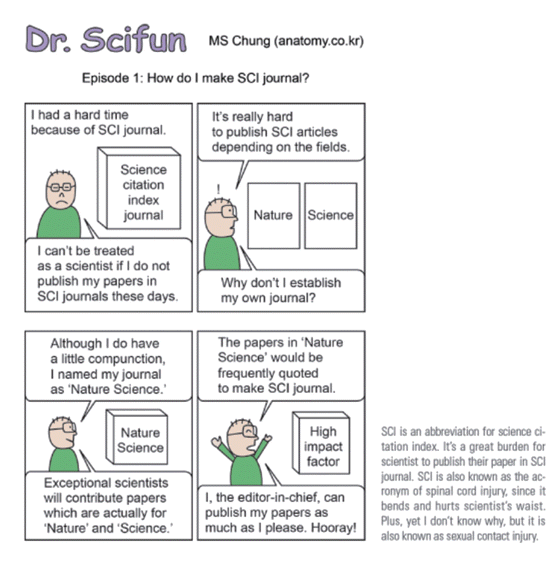Contributions of the comic strips on scientific articles
Article information
Introduction
The corresponding author has drawn the comic strips, entitled “Dr. Scifun,” which depict scientists’ various events with funny jokes. Among the hundreds of episodes of comics, decades deal with scientific articles [1]. Editor of the journal, Science Editing, decided to serially publish the episodes about articles in every issue [2]. It was because Science Editing, the journal about journals, also includes light topics in its scope (Fig. 1) [2]. The purpose of this essay is to make known how the comic strips on scientific articles can contribute to the interested persons.

An episode of comic strip for the scientists, published in the last issue of Science Editing. The title involves the author name, homepage address, and the episode number. Additional explanation is located at the right bottom side. This episode is satirizing the scientists’ strain about articles [2].
Comic Strips for the Scientists
Through the comic strips, scientists can develop a bond of sympathy. Regardless of the separate fields, researchers have the common denominators about articles. The importance of wording, the difficulty of getting reviewed, and the joy of getting published are almost same among the spheres. These stories are depicted in funny comic strips. Sharing the jokes of the comics, the scientists from diverse fields may get on with each other. The good atmosphere would hopefully play a part in the interdisciplinary convergence research (Fig. 1) [2].
Comic Strips for the Graduate Students
By reading the comic strips, graduate students can obtain the author’s message concerning the articles. The students then might regard writing an article as important as doing an experiment. Moreover, the comics illustrate the proper attitude and skill of an efficient writer, which may help the novice students. Thanks to the humorous tone of the comics, the students will banish the fear of writing job and remember the lesson effectively (Fig. 2).

Upcoming episodes of comic strips for the graduate students. The importance of reporting one’s research through journal articles is emphasized with a historical metaphor (A). The logic of making a table for the article is presented with an intriguing example (B). The roles of authors in an article are elucidated (C).
Cooperation of researchers is also explained in the comics. After reading them, graduate students may learn how to work together in lab, especially with their academic advisors (Fig. 2).
Comic Strips for the Laypeople
When seeing scientists depicted in the comics, laypeople are expected to feel a personal touch of the scientists. Since the comic strips liken article writing to daily life, laypeople may easily grasp what scientists’ jobs are. Main protagonist, Dr. Scifun, shows his zany personality, breaking the expected solemnness of scientists. Paradoxically, exposing an embarrassing aspect of the scientists will tear down the walls between scientists and others (Fig. 3).

Upcoming episodes of comic strips for the laypeople. The dilemmas that scientists undergo during their research are introduced (A). The daily human relationship is compared to the peer reviewing of the journal article (B) A figure is taller than B figure.
Once feeling close to scientists, laypersons may develop more interest in the scientific news and the scientific lecture. Once the juvenile readers, who dream of becoming scientists, realize that writing skill is essential to scientists, the youngsters will diligently learn composition in their school.
Comic Strips for the Journal, Science Editing
The newborn journal, Science Editing, is free to fulfill ingenious ideas [3]; one of them is publishing these comics [2]. As far as we know, this courageous attempt is the first among innumerable academic journals. The topics of Dr. Scifun and those of Science Editing can enter into a common interest. An instance is the plagiarism and duplication of articles. Our comics possibly give tiny help to Science Editing, fostering a scientific article culture (Fig. 4).
Conclusion
The beneficial science comic strips may be further utilized. For the lectures about the skills and ethics of article writing, our comic strips can be put in the presentation slides or handouts. The image files of comics are procurable on the homepage (anatomy.co.kr). While this Dr. Scifun is made from the perspective of professors, another cartoon, PhD Comics, is from the perspective of graduate students [4,5]. Likewise, every work of comics has a distinct individuality. Authors expect more and more comics on scientists’ activities to be manufactured, promoting fruitful communication about science and articles [6].
Notes
No potential conflict of interest relevant to this article was reported.
Acknowledgements
This research was supported by Basic Science Research Program through the National Research Foundation of Korea (NRF) funded by the Ministry of Education (grant number 2014R1A1A2053405).

